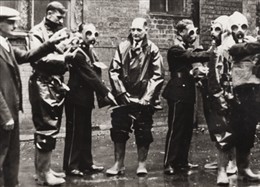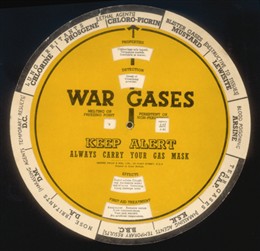Civil Defence in St Marylebone

Air raid drill and anti-gas exercise by Civil Defence personnel, 1940
Copyright Westminster City Archives

Air raid drill and anti-gas exercise by Civil Defence personnel, 1940
Copyright Westminster City Archives
_[f352-9355]_s.jpg)
Civil Defence meeting (boxing ring)
Copyright Westminster City Archives

Gas identification chart and particulars of all known gases
Copyright Westminster City Archives
1939-1945
By Rory Lalwan
St Marylebone set up its air-raid report and control centre in the Town Hall in Marylebone Road. From here direction was given for the creation of public shelters, the enforcement of lighting restrictions, and the establishment of air-raid warning systems and a wardens service.
The borough was divided into four divisions, with each division sub-divided into five groups, a bombing incident reporting post attached to each group. Among the twenty reporting posts were Lord's Cricket Ground, the St John's Wood Road Synagogue, the RIBA building, the Langham Hotel, the Francis Holland School, All Saints' Parish Hall, the De Walden Institute, the Portman Day Nursery, and the Salvation Army Hostel in Lisson Street. Throughout the war notice of bombing incidents were rapidly relayed from the reporting posts to the Town Hall, by phone or messenger, detailing the type of bomb, its effects and any actions required.
Across the borough facilities were set-up for the care of casualties, first aid posts established, stretcher parties and an ambulance service formed, hospitals and mortuaries made ready. Depots were created for rescue, repair, decontamination, and demolition parties.
At full strength the borough's civil defence personnel numbered some 2,400, including 936 women. There were 1,136 ARP wardens, 284 of whom were women.
Whilst the dreaded knock-out blow was not struck upon the breakout of war in September 1939, a year latter the blitz upon London began, with large-scale bombing of the East End and south east London, shortly followed by raids upon London's central boroughs. By March 1945, when the last V2 rockets fell upon London, almost thirty thousand civilians had perished during the bombing of the capital.